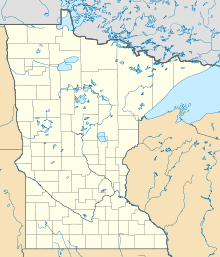Mill Ruins Park
Coordinates: 44 ° 58 ′ 49.29 " N , 93 ° 15 ′ 28.16" W.
Mill Ruins Park is a park in central Minneapolis , Minnesota , on the western side of the Saint-Anthony Falls of the Mississippi River . The park illustrates the history of Minneapolis' flour mills and shows the ruins of several abandoned flour mills.
The park is the result of an archaeological study by the Saint Anthony Falls Historic District , which has been inscribed on the National Register of Historic Places since 1971 . In 1983, consideration was given to widening the West River Parkway along the western bank of the Mississippi River in central Minneapolis. Then-county archaeologist Scott Anfinson of the Minnesota Historical Society came up with a proposal to make the archaeological sites accessible along the riverside route. A series of experimental excavations uncovered a wide variety of sites that contained various objects of interest. The foundations of two sawmills and a locomotive shed were found in the Bassett's Creek area , while an investigation near Hennepin Avenue uncovered the foundations of the Great Northern Railway Union Depot and the tower foundations of the first and second Hennepin Avenue Bridges. In the Mühlenviertel, the archaeologists found evidence that there are still extensive remains of the mill foundations and the canal system that the water power supplied.
The beginning of the archaeological investigations in the 1980s served to save the ruins from the total destruction that threatened them as a result of the road construction project. Later, in the 1990s, attention shifted from environmental influences to the availability of the ruins for the purpose of showing their value. All ruins were made available to the public and the aim was to create value for education, tourism and the commercial development of the area. Excavations for Mill Ruins Park began in 1998 and continued through 2001. The work also included stabilizing the remains of Washburn A Mill , which burned down in 1991 and which became part of the Mill City Museum .
Along with the remains of several mills and other industrial buildings, two stone pillars and several iron girders of a steel framework construction of the Minneapolis Eastern Railroad have been preserved in the park . The routing of the underwater of the hydropower canal is also clearly visible and the flow of water has been restored in the canal. Signs on the sidewalks explain the ruins and the history of the site.
Individual evidence
- ↑ a b Anfinson, Scott F .: Unearthing the Invisible: Archeology at the Riverfront . In: Minnesota History . 58, No. 5, pp. 320-331. ISSN 0026-5497 .
Web links
- Minneapolis Park & Recreation Board - Mill Ruins Park (English)
- Anfinson, Scott F. (1989). Archeology of the Central Minneapolis Riverfront, Part 1 and Part 2 . Accessed August 14, 2007


